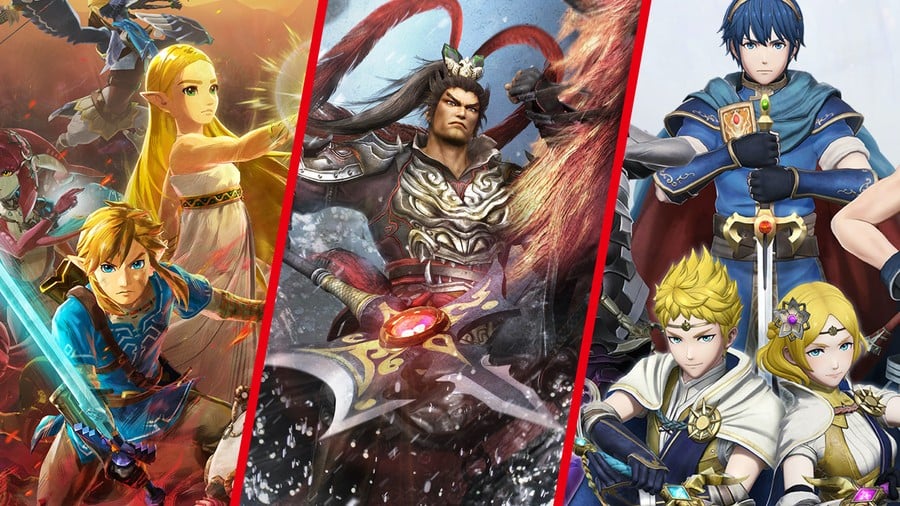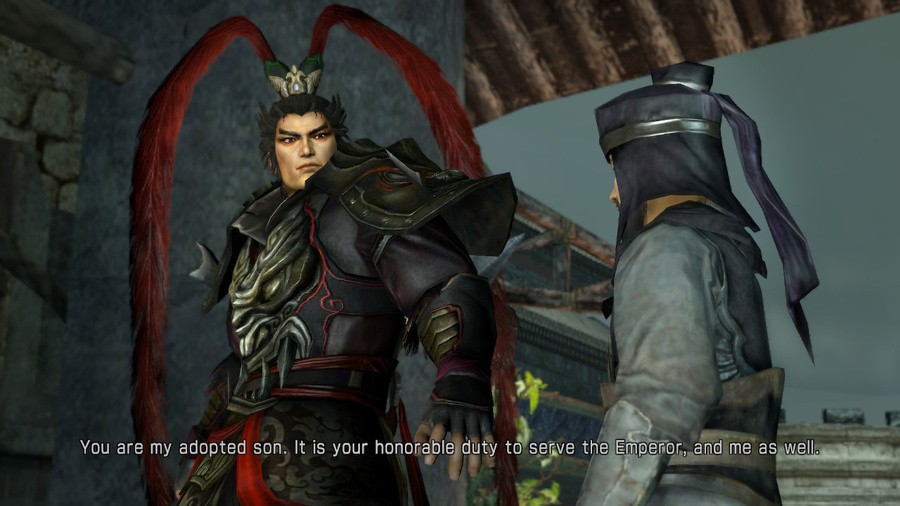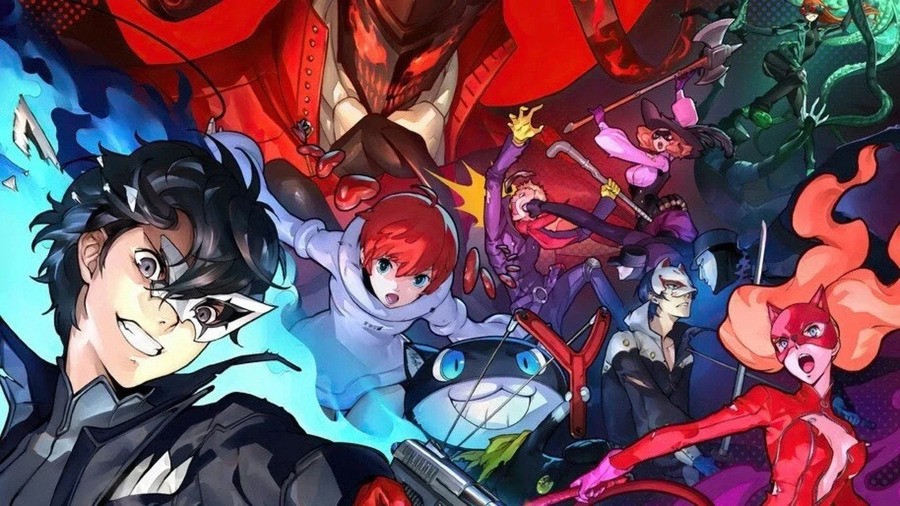
When you consider how few main Dynasty Warriors / Musou entries have come to Nintendo platforms, it’s almost strange how much influence Koei Tecmo’s hack-and-slash series has upon the Switch library. Developed by Omega Force, their main Nintendo output has mostly been spin-offs outside of 8: Xtreme Legends and strategy focused Dynasty Warriors 8: Empires (which remains Japan-exclusive on Switch). With Hyrule Warriors: Age Of Calamity bringing in 3 million sales after a week and Persona 5 Strikers exceeding sales expectations in Japan alone (and finally coming to the West in February), they’ve given us some remarkable games and for this feature, we’re taking a look at how it all began.
Contextually, this recent reputation is quite fitting when you consider that Dynasty Warriors was a spin-off series too, coming from turn-based strategy series Romance of the Three Kingdoms (for brevity, let’s call it ROTTK).
Early entries could be found on NES/SNES, ROTTK IV being the last one, but like many third-party developers, Koei mostly drifted away from Nintendo during the N64-era. It only truly returned in 2007 with ROTTK XI’s Wii release and even then, support is very sporadic. ROTTK XIII also arrived on Switch but like 8: Empires, that port remained Japan-exclusive.
Let's not forget Samurai Warriors either, which replaces Dynasty Warriors / ROTTK’s ancient Chinese setting for Japan’s Sengoku period. Early entries skipped Nintendo consoles but come 2010, Samurai Warriors 3 launched on Nintendo Wii, an entry we quite enjoyed back then. 4 and Spirit of Sanada are also on Switch but, you guessed it, only in Japan. Remarkably, this led to yet another sub-series with three-man teams called Warriors Orochi, merging Dynasty/Samurai Warriors into one. We’ve received better Western support for Orochi and they’re fun games but, generally, we didn’t think that highly of them.

You could easily get lost in Koei Tecmo’s near-endless entries in the series but ultimately the crossovers are what have held the most mainstream interest, all retaining that core Dynasty Warriors gameplay. For those unfamiliar with that gameplay, it usually sees you controlling one singular (practically superhuman) fighter across a large battlefield, taking over outposts occupied by enemy hordes. Doing this means crushing their commanders and defending these locations once captured. Most games suffer from repetition issues and arguably shallow combat but there lies an undeniable satisfaction in sending countless waves of enemies flying around you.
there lies an undeniable satisfaction in sending countless waves of enemies flying around you
We’ve seen plenty of less notable crossovers like Fist of the North Star: Ken’s Rage 2 and One Piece: Pirate Warriors 3, but from a Nintendo fan's perspective the real fun began in 2014 with Hyrule Warriors on Wii U. Within this non-canon entry, we found a story that celebrated The Legend of Zelda’s history with high levels of fan service. Thanks to an evil sorceress called Cia who seeks to revive Ganondorf, Hyrule Warriors merged Zelda’s different timelines and let us pick from a wide cast of characters including Link, Zelda, Midna, Darunia and Impa. Showcasing more action-packed gameplay, Hyrule Warriors opened up new possibilities for Zelda fans and remains an entertaining tribute. Despite the window dressing, however, it's important to remember that it's a Dynasty Warriors game with Zelda trappings, not the other way round.
We got two later iterations of it, ported to 3DS with Wind Waker content and a Definitive Edition arrived for Switch, but for Nintendo this ride was far from over. Fire Emblem Warriors arrived a few years later and it built upon the foundations set before. As a series that helped pioneer the tactical RPG genre, seeing this aspect disappear was certainly unusual but Omega Force tried capturing that spirit of Nintendo's series within a wider action setting, letting you issue orders to allies across the map and incorporating Fire Emblem’s famous weapons triangle.
This wasn’t the perfect experience sadly and though it was certainly enjoyable, a messy story and unusually weighted roster took the shine off for some. Excluding the original characters, Warriors had a chance to draw from Fire Emblem’s rich history that, at the time, spanned across twelve main entries; it ended up drawing almost exclusively from just three: Shadow Dragon, Awakening and Fates. The only exceptions were one-offs — Lyndis from The Blazing Blade and Celica from Shadows of Valentia — making it a missed opportunity to celebrate the wider series.
By merging more traditional gameplay elements of these franchises with Dynasty Warriors’ signature gameplay, these crossovers presented a new set of opportunities
Despite these early flaws, a consistent trend had formed. By merging more traditional gameplay elements of these franchises with Dynasty Warriors’ signature gameplay, these crossovers presented a new set of opportunities. Letting publishers market something deeply familiar but remarkably fresh, Nintendo spotted a winning formula early that they’ve built upon since. Better yet, they weren’t alone.
Atlus was already known for releasing spin-offs that are also sequels (hey Persona 4 Arena!), so it wasn’t surprising that they found potential in this approach, too. Initially envisioned as a “Persona Warriors” game that covered multiple entries, they eventually settled on a direct follow up to Persona 5 (sorry Royal fans, that new story isn’t referenced) and Japanese Switch owners received Persona 5 Strikers back in February. Taking place six months after P5, the Phantom Thieves of Heart have reformed as they investigate a new wave of mysterious incidents, now travelling across Japan.

Like Fire Emblem Warriors, Strikers ditches the turn-based approach of its parent series for hack-and-slash gameplay but keeps core elements, such as Persona fusions inside the Velvet Room. Although the original game hasn’t come to Switch — a fact that remains a major point of contention with some fans — next year’s western launch for Strikers remains eagerly anticipated. Interestingly, Atlus has also teased additional “exciting plans” for the series’ 25th anniversary in 2021, so whilst Switch ports are a possibility, another Strikers game could be on the cards too.
Age of Calamity is one of the most accessible entry points for the genre yet... the fastest-selling Musou game of all time
It makes quite a contrast with Age of Calamity then, which adopted a similar mentality but took the prequel route instead, unlike Hyrule Warrior’s non-canon approach. Set 100 years before The Legend of Zelda: Breath of the Wild begins, this recent entry details what happened during the Second Great Calamity and Calamity Ganon’s eventual revival. It builds upon Hyrule Warriors’ foundations well, keeping basic combat in place but adds numerous features that bring gameplay elements of Breath of the Wild into play, such as cooking, discoverable Koroks and Sheikah Slate abilities.
It made for an experience unlike anything we’ve ever seen in the official Zelda canon, expanding upon Breath of the Wild’s rich world with a high level of polish. Although it also falls into that repetition trap and can struggle with performance (especially during co-op), we thought it was great and Age of Calamity is one of the most accessible entry points for the genre yet. Not only does it set a high bar for these crossovers, it felt right at home within the Legend of Zelda series, becoming the fastest-selling Musou game of all time.
Combined with Persona 5 Strikers’ early success in Japan and positive previews, both games have built upon strong foundations which marry elements from other series with the best of the Warriors gameplay, and it bodes well for this format. As for what comes next, we could speculate forever about third-party crossovers. Nintendo doing 'Super Mario Warriors' or 'Animal Crossing Warriors' seems extremely unlikely, though Star Fox or Kid Icarus could potentially fit the bill. Whatever's next in the pipeline, if Omega Force can continue creating such polished experiences, we’ve got plenty to look forward to.
Comments 43
I find the One Piece ones a little stale but Hyrule Warriors was great because it married the best parts of Warriors games with the distinctive Zelda style. Adventure mode was absolutely fantastic in Hyrule Warriors.
Persona 5 Strikes is a Musou? I thought it was a hack'n slash, like DMC or Bayonetta 😔
I still would like a port of Fist of the North Star: Ken's Rage 2 on Switch. Not the greatest musou, but I love that IP.
Mushroom Kingdom Warriors please. It could feature platforming elements and it would be awesome.
@RCGamer its a mix of both. it also has persona 5 elements
@Yosher i realllllly want a mario warriors game!!!
I really wish they had included online with AoC. There's nothing I find more boring than grinding through a musou game solo - having a friend along that you can chat and laugh with as you mindlessly mow down the faceless horde is a great way to kill an evening.
Talking hack and slash games, I would love Senran Kagura estival versus and Burst re:newal on Switch (as well as peach beach splash but thats more splatoon than musou)
Picked up FE Warriors recently. It's pretty cool that you can give the AI tactical orders from the pause menu.
Believe it or not, Koei Tecmo have ever released a fashion game with Tokimeki style on 3DS with title Fab Style. 😛

It rated CERO B for having virtual dating with handsome men. Well, of course...
So, Koei Tecmo with their Dynasty Warrior style games also can provide a Style Savvy game like Nintendo.
@nessisonett it was! l wish l can play it again but l don't know how to transfer the data from old sd card to my main one.
@NikHogan that will be funny. if they did released one then l would get it!
The spin-offs allow the most creativity with the formula, whether it's the absurd masterpiece of One Piece or even my personal favourite Berserk and the Band of the Hawk it makes each one feel unique.
If all you played were the Dynasty, Samurai or Orochi games you might not appreciate it but the formula can be applied and tweaked or enhanced with just about any property.
@Anti-Matter They could always just make a New Style Boutique Warriors. Slay hordes of enemies while walking the catwalk and look fabulous while you do it!
I enjoyed HW Warriors/Legends and FE Warriors, but Age of Calamity and P5S seem like the Devs are trying something new.
Almost like they're putting the warriors gameplay into the original games instead of vice versa?
I'm sure it will be fun anyway, these are like the comfort food of gaming
@nessisonett
New Style Savvy Warriors: Femme Fatale 🤣🤣🤣
These games suck.
Fire Emblem Warriors is still my favorite Musou game - not giving up hope for a sequel some day!
I would love a Xenoblade Warriors!
@RCGamer it's literally a persona game with ARPG instanced combat like DMC and Bayonetta and Kingdom Hearts. It is not a musou like AoC and was never marketed as such or said to be such by the developers. They explicitly said in an interview that it started as that but they changed course early in development but someone put it on the wiki that it is a Warriors game so it's a Warriors game 🤷♂️
@HIGHscores85 thats your opinion lol
Suprised you didn't mention Attack on Titan 2, I have that on the switch and I love it
@Anti-Matter "Style Savvy Warriors: Femme Fatale"
DAY. ONE. BUY.
Don’t forget Dragon Quest Heroes.
@HIGHscores85 Just curious, and I apologize if you aren’t the same person... but were we friends on Wii U? You’d follow my heavy metal artwork on Miiverse and stuff?
Fire Emblem Warriors got stale for me a bit too fast, but Age of Calamity has been a really nice surprise. Whoever says that you just button mash or that it's just mindless combat is playing it wrong. You could say the same about fighting games, beat' em ups or hack n'slash games (which these are in my opinion) but that doesn't mean that you are really taking advantage of the combat system in said genres. Sure, you'll probably complete most of it's content eventually, but you'll have a terrible time doing it and some content can't be finished that way. Also yeah, the combo system in these games is generally simple in terms of structure, but learning a character properly is another thing. This last Warriors game surprised me with how different characters feel.
@VR32X Yep it's me. Nice to see you!
Love me a good warriors game.
@HIGHscores85 Is there a way to PM on here? Would like to catch up sometime. Hope you’re doing well!
Wake me up when there's a Xenoblade Warriors set on the Bionis.
I think that a Kingdom Hearts Warrior game would be.... AMAZING! So many keyblade wielders, Organization 13, main bosses, disney characters..... they would have a huge roaster haha
Age of Calamity is my favorite Warriors game right now! I really wanna try out Persona 5 Scramble. Love these Dynasty warrior genre games.
@roy130390
Yes! I was surprised by the character roaster and the wide ranges of characters. My mains are Impa and Mipha and these two have different approaches to enemies... really awesome!
Wished more anime crossovers would happen...but yeah I've only played the original Hyrule warriors, kinda wished a 2 happened instead of Calamity. Not a big BotW fan honestly....
But yeah the devs said they wanted to do Mario next, and that was a while back, too. >.<
I didn't know fe had one. Why not the final fantasy franchise?
Koei is kinda like shadow company TOSE when it comes to their Warriors games - their output is only as good as the effort their licensing partner puts in. I like these games but I won't deny that the quality is all over the place.
Age of Calamity has proven to me that Koei Tecmo and Omega Force can become as serious as they can be when it comes to crossovers. With the supervision of Nintendo, they were able to bring out one of the best successors that I've ever played. The first Hyrule Warriors was great, but Age of Calamity knocks it out of the park for me.
Yes, I am aware that AoC runs worse than HWDE, but I personally feel like the story and soundtrack definitively outweighed the performance issues, and AoC is a game that doesn't require ludicrous amounts of gameplay in order to achieve 100%.
No One:......
Absolutely No One:......
Me: TOY STORY WARRIORS
When you're talking about Dynasty Warriors, know that the original first Dynasty Warriors itself wasn't a Musou game, it was a fighting game (technically a Soul Blade/Soul Edge/Soul Calibur ripoff). Starting with Dynasty Warriors 2 was when it became a Musou game and has been like that forever.
The original Dynasty Warriors
Dynasty Warriors 2 from a fighting game to Musou a.k.a. hack and slash. What a change huh!
Wouldn't a Star Wars Musou game be really cool? Like, you're Darth Vader and you are mowing down troop after troop of rebel scum.
I know I’ll eventually pick up AoC down the line. I’m just wondering whether the previous version of HW is still worth picking up. (Context: I am a Zelda fan and did enjoy the DW games on PS2). It seems physical copies aren’t really available so I may have to consider digital if physical is just not feasible (but I shall still wait for a sale!).
@archangelg
The first Hyrule Warriors is worth picking up if you're interested in most Zelda games, other than Breath of the Wild. In terms of getting 100%, it has far more content than Age of Calamity (Hyrule Warriors Legends and Definitive Edition). If you're looking for something more story-oriented, then Age of Calamity is the better game.
@nessisonett Are you talking about Age Of Calamity or Definitive addition?
@LatsaSpege The original on Wii U. Adventure mode was fantastic.
I think a Mushroom Kingdom Warriors is quite likely personally, along with Pokemon and Xenoblade it seems like a no-brainer, would love a Starfox version too but i can't quite see that happening sadly.
I've really enjoyed all the Nintendo ones but i like the One Piece and Dragon Quest Warriors games too, they're not the kind of game i cold play back-to-back but they're a nice palette cleanser in between more intense games i find
Tap here to load 43 comments
Leave A Comment
Hold on there, you need to login to post a comment...